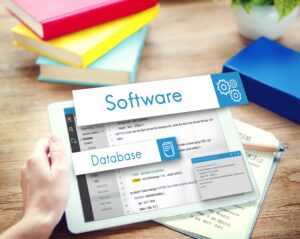Is your hiring process more ‘chaotic’ than ‘efficient’? Are you constantly juggling tasks and feeling like you’re always one step behind? We have just the solution to address your struggles right away!
A recruitment database software is the friend you need. It brings order to your talent acquisition efforts, gives you the time and the tools to strategize and make data-driven decisions.
Sift through this guide and explore everything you need to know about this powerful recruiting technology.
What is a recruitment database software?
![]()
A recruitment database software is no less than a game-changer in the talent acquisition landscape.
It is a specialized tool designed to automate and streamline the recruiting process, acting like a digital command center for all your hiring activities to make the process faster and more effective.
At its core, a recruitment management system is all about data – collecting it, organizing it, and making it easily accessible. Instead of sifting through stacks of job applications or multiple spreadsheets, you can simply search the database to find the information you need.
But its utility is not just restricted to a storage solution. An applicant tracking software– a popular type of database software for recruiters, is designed to facilitate the entire recruitment process.
From posting job ads on multiple job boards at once to tracking applicants as they move through the recruitment funnel, this software automates several repetitive tasks off your plate.
5 key features of a recruitment database software

1. Job posting
In the digital age, job seekers are scattered across numerous job boards and platforms. Posting job openings manually on each of these platforms can be a time-consuming and tedious task.
The job posting feature of the software streamlines this process.
With just a single click, you can post open positions on multiple job boards, social media platforms, and the company’s career page.
This ensures that your job descriptions reach a wider audience of potential candidates.
2. Resume parsing
Going through each resume manually to extract relevant information from candidate profiles is a task that requires a significant amount of time and attention to detail.
This is where the resume parsing feature of a recruitment database system comes to your rescue.
It uses natural language processing (NLP) technology to automatically extract information from resumes, such as the candidate’s name, contact information, skills, and work experience.
This saves a huge chunk of time from your calendar pre-screening and helps you overcome the fuss of manual data entry. It also reduces the risk of human error.
3. Candidate tracking
The candidate tracking feature simplifies the process of keeping track of the progress of each applicant.
It provides a visual representation of each candidate’s progression in the talent pool, from the initial application process to the final hiring decision, in real-time.
This allows you to easily see where each candidate is in the process, follow up after every step and assess future actions.
4. Interview scheduling
The interview scheduling feature does a great job of setting up calls conveniently.
You and your candidates can set your availability, then choose a suitable time slot, offering peak flexibility for an excellent candidate experience.
The HR software automatically sends out calendar invites and reminders, ensuring that everyone is on the same page.
5. Reporting and analytics
Making data-driven decisions backed by actionable metrics is crucial in modern recruitment. Here reporting and analytics comes in handy, providing recruiters with valuable insights into the recruitment process.
It can track metrics such as time-to-fill, cost-per-hire, source of hire, etc., and present this data in easy-to-understand reports and dashboards.
This way, you can identify trends, spot bottlenecks, and make informed decisions to improve your overall recruitment strategy.
2 major types of recruitment database software
I. On-premise solutions
On-premise recruitment database software is installed and runs on the organization’s own servers and computers. It is often chosen by organizations that have strict data security requirements or that prefer to have direct control over their software and data.
However, this solution often requires a significant upfront investment in hardware and software, as well as ongoing costs for maintenance and updates.
They require the organization to have the IT expertise to install, maintain, and troubleshoot the tool as and when needed.
II. Cloud-based solutions
Cloud-based recruitment database software, on the other hand, is hosted on the vendor’s servers and accessed through a web browser. It is also known as software as a service (SaaS).
Note: Cloud-based recruitment database software is hosted on the vendor’s servers and accessed through a web browser. Make sure to use a private browser search engine when accessing such software.
One of the main advantages of cloud-based solutions is that they require a lower upfront investment compared to on-premise solutions. The software vendor takes care of all the maintenance, updates, and troubleshooting, freeing up the organization’s IT resources.
Cloud-based solutions are also scalable, meaning they can easily be expanded or contracted based on the organization’s needs. They can be accessed from anywhere, which is particularly beneficial for organizations with remote or distributed teams.
4 top benefits of a recruitment database software

1. Enhanced efficiency
A recruitment database software enhances efficiency in candidate sourcing (even from platforms like LinkedIn) and tracking by automating various tasks.
It allows recruiters to post job ads to multiple job boards with a single click, track the progress of candidates throughout the recruiting process, and employ artificial intelligence to rank qualified candidates based on predefined criteria.
2. Improved collaboration and communication
It improves collaboration and communication within recruitment teams by providing a centralized platform for messaging where all the members can access and update the candidate information.
This ensures that everyone is on the same page and reduces the risk of miscommunication.
3. Advanced search and filtering
With a recruitment software, you can seamlessly search for better candidates based on various criteria, conduct extensive background checks and filter the results to find the right candidate to align with your specific checklist.
This helps you shortlist the best candidates with better speed and efficiency.
4. Compliance and data security
A recruitment CRM helps organizations comply with various recruitment-related laws and regulations. It ensures that all hiring activities are conducted in a fair and transparent manner.
It also provides features such as data encryption and access controls to ensure the security of candidate data.
5 parameters to choose the best recruitment database software for your hiring needs
1. User convenience
A recruitment software should be user-friendly and intuitive, allowing even non-technical users from HR teams to navigate and utilize its features with ease. This includes a clean and organized interface, clear instructions, and a smooth user experience.
The user-friendly nature of the software can significantly affect the efficiency and productivity of recruitment agencies. So, it’s always advisable to opt for a solution that offers a free trial or demo, allowing your hiring team to test its usability before making a decision.
2. Customization
Every organization has unique hiring needs and processes. This variation in requirements calls for a high degree of customizability in your ATS to adapt to these unique needs.
It can range from customizable fields and workflows to reports and notifications. Customizability ensures that the software can grow and adapt to your organization, providing long-term value.
3. Integration capabilities
In today’s interconnected digital workspace, recruitment database software should be able to integrate seamlessly with other HR systems and tools that your agency uses.
This could include HRIS, payroll systems, onboarding tools for new hires, or even emailing platforms.
Integration capabilities ensure a smooth flow of data across systems, reducing the risk of errors.
4. Customer support
Even with the most intuitive software, issues can arise. So, the best recruitment database system vendor must provide reliable and responsive customer support to improve their customer success process even further.
This could be in the form of live chat, email, phone support, or a comprehensive knowledge base. Good customer support can make the difference between a minor hiccup and a major disruption in your candidate selection process.
5. Pricing
Finally, the cost of the software is an important consideration. This doesn’t just include the upfront cost of the tool but also ongoing costs such as maintenance, upgrades, and additional features.
The software should offer good value for money, providing a robust set of features and benefits for a reasonable price within a tight budget. It’s also important to understand the pricing structure, whether it’s a one-time fee, a monthly subscription, or a pay-per-user model, to ensure it fits within your budget.
5 steps for implementing a recruitment database software

1. Data migration and system setup
Migrating your existing candidate data into the new system is a crucial step while implementing a database software. This involves exporting data from your current system, cleaning and organizing the data, and then importing it into the new software.
It’s crucial to ensure that all the information is transferred accurately and securely. After the migration process, the system needs to be set up according to your organization’s needs.
This includes configuring settings, customizing fields and workflows, and setting up user accounts and permissions.
2. User training and onboarding
Once the system is set up, it’s important to provide comprehensive training to all users. This should cover how to navigate the software, how to use key features, and best practices for efficient use.
Training can be provided through live sessions, recorded videos, or written guides. It’s also beneficial to have a ‘sandbox’ environment where members can practice using the software without affecting real data.
3. Testing
Before fully launching the software, make sure you conduct thorough testing to ensure everything works as expected. This includes testing features, workflows, integrations, and data accuracy.
Any issues discovered during testing should be addressed before the software is rolled out to all users to avoid a mess that can compromise the security and credibility of your database.
4. Rollout
After testing is complete, the software can be rolled out to all users. It’s beneficial to have a phased rollout, starting with a small group of users, to monitor for any issues and gather feedback before rolling it out to the entire organization.
It’s always advisable to start with the tech-savvy team, preferably the IT department, for prompt identification of any issue that may continue to arise.
5. Feedback and optimization
Once the software is rolled out, it’s important to gather feedback from users and monitor its competitive performance. This feedback can be used to make adjustments and optimizations to the system.
This could include tweaking settings, adding custom fields, or adjusting workflows in order to create a uniform synchronization between the software and the existing work structure or pattern.
P.S.: If you’re looking for an AI-powered recruitment database software, then don’t forget to check out Recruit CRM. Book a demo to see the tool in action.
Frequently asked questions
1. How robust is the security of recruitment database software?
Recruitment database software typically incorporates robust security measures to safeguard both candidate and employer data.
These measures may include encryption, access controls, and data backups.
It’s crucial to thoroughly investigate the security protocols of any recruitment solution before making a selection.
2. In what ways does recruitment database software contribute to reducing bias in the recruitment process?
Recruitment database software plays a pivotal role in mitigating bias by enabling a more objective evaluation of candidates.
By shifting the focus from subjective criteria to objective factors such as skills and experience, it allows recruiters to assess candidates purely based on merit, fostering a fair and inclusive recruitment process.
3. Can recruitment database software be utilized to manage freelance or contract workers?
Indeed! Recruitment database software provides a comprehensive solution for managing freelance or contract workers.
It offers dedicated tools that allow easy tracking and management of contractor information, including contract specifics, invoicing, and payment management.
By leveraging this solution, you can efficiently manage your entire freelance or contract workforce, ensuring smooth operations and effective collaboration with these vital contributors to your organization.




